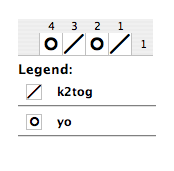Yarn Over Stitch

Places where you will find yarn overs:
- Increases: A yarn over is a common way of
increasing the number of stitches. It is the simplest
increase made between two existing stitches. On
following rows, the yarn over will be knitted, making
a new stitch. There is a disadvantage to this though.
A small hole (eyelet) is created where the yarn over
is. This hole can be diminished by twisting the yarn
over stitch which will be a result similar to a make1
stitch.
- Elongated stitches: You can knit a row of
elongated stitches that will result in a horizontal
stripe. However, when this row is combined with a
yarn over on the next row, it will create a diagonal
stripe. Because you can make long elongated stitches
when combined with a yarn over several rows later,
could create a pattern for flower petals on the
diagonal.
- Lace: Yarn overs are common in lace since this is
a way of creating holes that will hold securely in
the fabric.
- Plaited stitch: Yarn overs will result in a
plaited stitch when it is knit in the next row. Since
loom knitted works the back loop of the stitches,
this is generally how our yarn overs are done.
- Tucked stitch: Yarn overs are a fun way to slip stitches without passing the yarn over the front or back. A combination of a yarn over and a slipped stitch will result in a tucked stitch where the yarn is slipped over the slipped stitch instead of slipping in the front or back. These tucked stitches are the basis of brioche knitting.
Directions
Video
- Pick up the wrap on one peg and place it on
the peg next to it. There is now an empty peg
and a peg with two wraps.
- Make sure to wrap the empty peg when knitting the row to knit off in the next row.
Coming soon!






